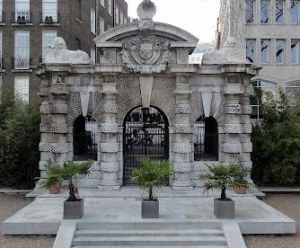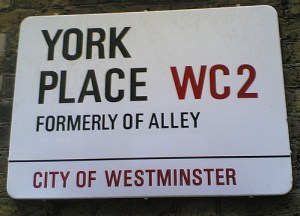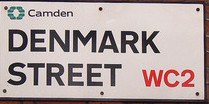 In years past the Thames river was much wider than it currently is, even containing numerous islands. There are few places where one can visualize the width of the Thames in prior centuries, but within the Victoria Embankment Gardens is a stone structure that allows you to do just that - sitting almost 300 feet adrift from the Thames today.
In years past the Thames river was much wider than it currently is, even containing numerous islands. There are few places where one can visualize the width of the Thames in prior centuries, but within the Victoria Embankment Gardens is a stone structure that allows you to do just that - sitting almost 300 feet adrift from the Thames today.
History: A large estate was originally built in this location in the 13th century for the Bishops of Norwich. It was confiscated by Henry VIII during the dissolution of the monasteries. It was then granted to the Archbishop of York in the 15th Century and became known as York House. The house was sold to George Villiers, the 1st Duke of Buckingham, in 1624. The location on the Strand was exclusive as there were very few estates along this road connecting the City with Westminster. Those estates located on the Thames side of the Strand naturally had access to the river. Shortly after acquiring the property, the Duke built a ‘water-gate’ at the bottom of the property’s garden, on the bank of the Thames, to provide easier access to the property for travellers by boat. This gateway is believed to have been built in 1626 by the Duke’s stonemason, Nicholas Stone, and some claim it was designed by architect Inigo Jones. To either side of the gate are covered arches where people could wait for their boat.
The gate’s design is Italianate, similar to other designs built during the reign of King Charles I. The Banqueting house, in nearby Whitehall ( see our post on this building http://londonunveiled.com/2012/06/28/banqueting-house/ for more information) is a grander period example of Inigo Jones’ s architectural works that also incorporates the Italianate design aesthetic.
After York House was inherited by the 2nd Duke of Buckingham the house was sold in 1672 to developers so that the Duke could raise capital to cover his debt obligations. The only condition of sale was that when streets were laid out in the new development every part of his name and title (George Villiers, Duke of Buckingham) must be included in the street names. In 1675, the house was demolished. A new street plan was laid out on the property and the original streets were George St (now York Buildings), Villiers St, Duke St (now John Adam St), Of Alley (now York Place - but with the footnote on the sign ’Formerly Of Alley’) and Buckingham St. At the south side of ths development is Watergate Walk where the stone Watergate is the only remaining structure from the York House era. By the late 19th Century the gate had fallen into disrepair. In 1893 the London County Council acquired the watergate so that it could be maintained for the public as part of the gardens.
developers so that the Duke could raise capital to cover his debt obligations. The only condition of sale was that when streets were laid out in the new development every part of his name and title (George Villiers, Duke of Buckingham) must be included in the street names. In 1675, the house was demolished. A new street plan was laid out on the property and the original streets were George St (now York Buildings), Villiers St, Duke St (now John Adam St), Of Alley (now York Place - but with the footnote on the sign ’Formerly Of Alley’) and Buckingham St. At the south side of ths development is Watergate Walk where the stone Watergate is the only remaining structure from the York House era. By the late 19th Century the gate had fallen into disrepair. In 1893 the London County Council acquired the watergate so that it could be maintained for the public as part of the gardens.
The Thames Embankment: In 1865 Joseph Bazalgette began construction of the northern Thames embankment, known as Victoria Embankment, to reclaim land from the Thames’ path. Construction finished in 1870. It also covers the then new sewer system for which Bazagette is also known. The narrowing of the Thames meant that the York Watergate was now landlocked - almost 300 feet away from the water’s edge. In front of it gardens were built connecting the Watergate to the Thames. A memorial to Bazalgette can be found on the embankment just south of these Victoria Embankment Gardens.
Artistic Connections: There are several well-known paintings of the York Watergate. These include Henry Pether’s ”York Watergate and the Adelphi from the river, by Moonlight” (c.1850) that envisions how it may have appeared in its prime. Another painting is John O’Connor’s ”York Watergate and the Adelphi from the river” (1872). Both are on display at the Museum of London (see http://tinyurl.com/cv77q97).
Located at: Victoria Embankment Gardens, WC2
Closest Tube: Embankment




